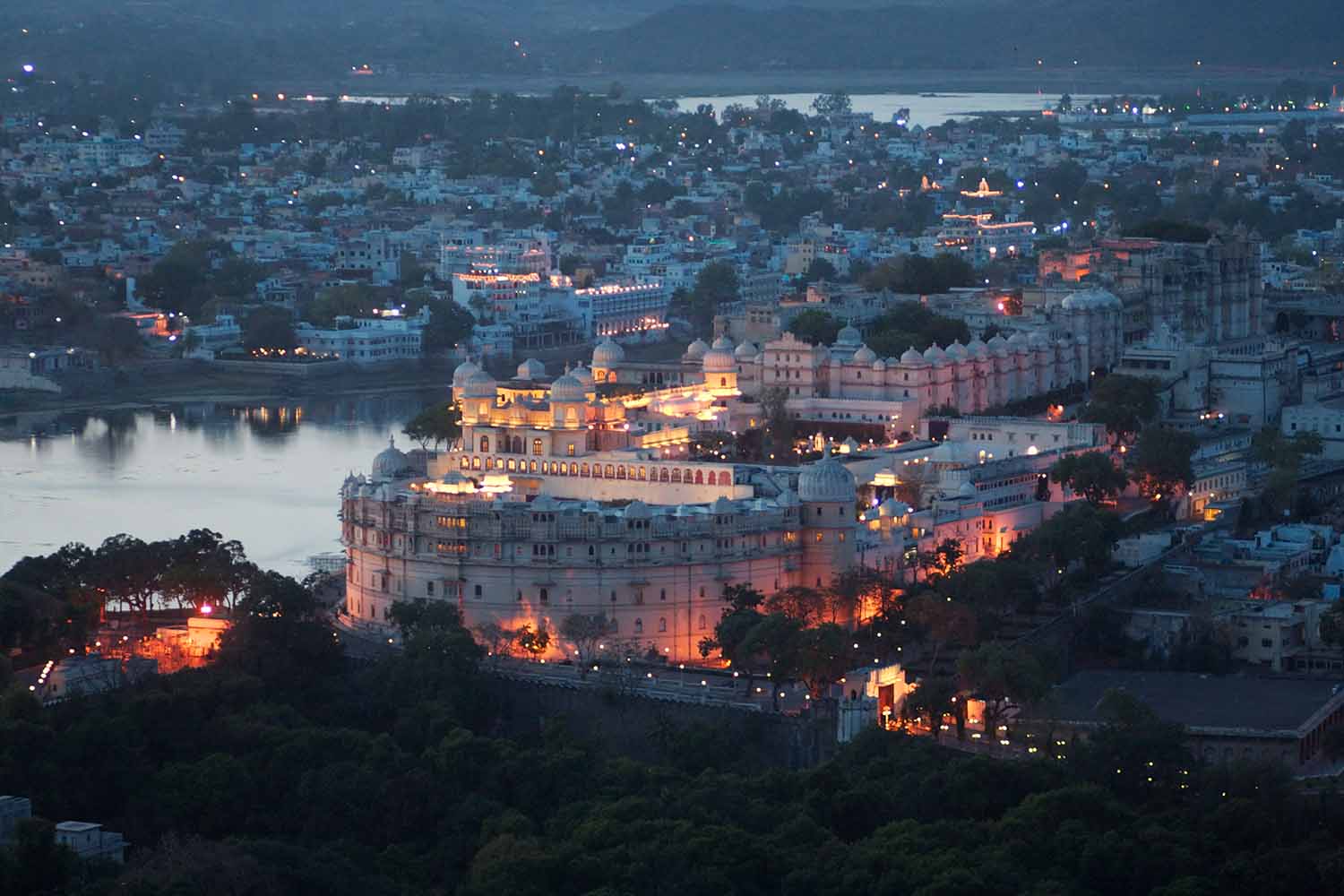Udaipur, known as the Venice of the East, boasts several sparkling lakes against a backdrop of the Aravail hills. Jag Niwas and Jag Mandir, islands in Fateh Sagar Lake, are the site of Udaipur Solar Observatory and Nehru Garden. Famous palaces include the magical Lake Palace, now a luxurious five-star hotel, and the massive City Palace on Pichola’s east bank, featuring epic courtyards and stunning paintings.
1. Lake Pichola
Lake Pichola, situated in Udaipur city in the Indian state of Rajasthan, is an artificial fresh water lake, created in the year 1362, named after the nearby Picholi village. It is one of the several contiguous lakes, and developed over the last few centuries in and around the famous Udaipur city.
2. City Palace of Udaipur
City Palace, Udaipur is a palace complex situated in the city of Udaipur in the Indian state of Rajasthan. It was built over a period of nearly 400 years, with contributions from several rulers of the Mewar dynasty.
3. Bagore Ki Haveli Museum
Bagore-ki-Haveli is a haveli in Udaipur in Rajasthan state in India. It is right on the waterfront of Lake Pichola at Gangori Ghat. Amar Chand Badwa, the Prime Minister of Mewar, built it in the eighteenth century.
4. Shri Ekling Ji Temple
Eklingji Temple has a marvelous architecture. The temple is double storied with colossal pyramidal style roof and remarkably carved tower which adds to its beauty.
The exterior walls of temples are stretched with stairs which directly descends in the water.
On entering the temple, you will greet a silver image of Nandi (bull). According to mythology, Nandi is considered to be the gate-guardian deity of Mountain Kailasa. There are two other carvings of Nandi in brass and black stone in the temple.
5. Jagdish Temple
Jagdish temple is one of the best architectural wonders of the Mewar dynasty. Jagdish temple showcases the Indo- Aryan architectural style. The temple is built keeping the rules of Vastushastra, the Hindu architectural science in mind.
This three-storied temple is built on raised platform flaunting magnificently carved pillars, huge airy halls and painted walls that are adorned with vibrant colors and intricately decorated ceilings. At the entrance, there are two massive elephants statues of stone, installed to welcome the visitors. An inscription engraved on the stone slab is found at the entry. Mahara Jagat Singh installed the inscription to record his contributions to the temple.
6. Srinathji Temple
The Swarup or divine form of Shrinathji is said to be self-manifested.[3] The deity of the Lord Krishna according to the legend, is self-manifested from stone and emerged from the Govardhan Hills. Historically, the image of Shrinathji was first worshipped at Govardhan hill, near Mathura. The image was initially shifted from Mathura in 1672 CE along river Yamuna and was retained at Agra for almost six months, in order to safeguard it from the Mughal ruler Aurangzeb, who wished to keep the prestigious deity with him in Agra. Subsequently, the image was transferred further south on a chariot to a safer place to protect it from barbaric destruction unleashed by the Mughal ruler Aurangzeb. When the deity reached the spot at village Sihad or Sinhad, the wheels of the bullock cart in which the deity was being transported sank axle-deep in mud and could not be moved any farther. The accompanying priests realised that the particular place was the Lord’s chosen spot and accordingly, a temple was built there under the rule and protection of the then Maharana Raj Singh of Mewar.[4] Shrinathji Temple is also known as ‘Haveli of Shrinathji’ (mansion).[5] The temple was built by Goswami Damodar Das Bairagi in 1672.[6]
7. Sajjangarh Monsoon Palace
Located on a Bansdara peak of Aravalli hill (3100 ft above sea level), Sajjangarh Palace is built with stunning white marble. As per the plan laid out by Maharana Sajjan Singh, the Palace was supposed to be nine stories, but due to the premature death of the King, the planned was shelved. However, it was later completed by Maharana Fateh Singh, his successor. The Royal family used the Sajjangarh Palace as a hunting lodge as well as to watch the monsoon clouds which brought the name of Monsoon Palace to the Sajjangarh Palace.
The foundation of the Fort is laid on marble pillars which have exclusive motifs of flowers and leaves carved all over it. The palace walls are plastered with lime mortar. There is a vast central court with a stunning staircase and several quarters and rooms. The Fort has high turrets and guards monitoring each of the towers. The domes, fountains, and jharokhas all around the palaces are the exquisite marvels of Rajasthani architecture.
8. Sahelion Ki Bari
Saheliyon-ki-Bari is a major garden and a popular tourist space in Udaipur in the Indian state of Rajasthan. It lies in the northern part of the city and has fountains and kiosks, a lotus pool and marble elephants. It was built by Rana Sangram Singh.
9. Jagmandir
Jag Mandir is a palace built on an island in the Lake Pichola. It is also called the “Lake Garden Palace”. The palace is located in Udaipur city in the Indian state of Rajasthan. Its construction is credited to three Maharanas of the Sisodia Rajputs of Mewar kingdom.
10. City Palace Museum
The City Palace, Jaipur is a royal residence and former administrative headquarters of the rulers of the Jaipur State in Jaipur, Rajasthan. Construction started soon after the establishment of the city of Jaipur under the reign of Maharaja Sawai Jai Singh II, who moved his court to Jaipur from Amber, in 1727.






